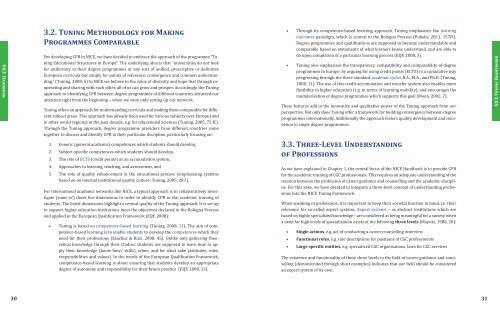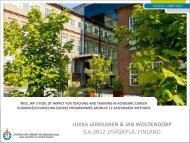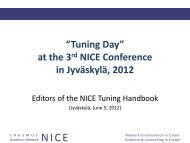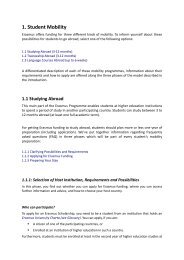NICE HANDBOOK â Academic training of Career ... - Nice-network.eu
NICE HANDBOOK â Academic training of Career ... - Nice-network.eu
NICE HANDBOOK â Academic training of Career ... - Nice-network.eu
You also want an ePaper? Increase the reach of your titles
YUMPU automatically turns print PDFs into web optimized ePapers that Google loves.
<strong>NICE</strong> Handbook3.2. Tuning Methodology for MakingProgrammes ComparableFor developing CPR in <strong>NICE</strong>, we have decided to embrace the approach <strong>of</strong> the programme “TuningEducational Structures in Europe”. The underlying idea is that “universities do not lookfor uniformity in their degree programmes or any sort <strong>of</strong> unified, prescriptive or definitiveEuropean curricula but simply for points <strong>of</strong> reference, convergence and common understanding.”(Tuning, 2008, 6) In <strong>NICE</strong> we believe in the value <strong>of</strong> diversity and hope that through cooperatingand sharing with each other, all <strong>of</strong> us can grow and prosper. Accordingly, the Tuningapproach to identifying CPR between degree programmes <strong>of</strong> different countries attracted ourattention right from the beginning – when we were only setting up our <strong>network</strong>.Tuning <strong>of</strong>fers an approach for understanding curricula and making them comparable for differentsubject areas. This approach has already been used for various subjects over Europe (andin other world regions) in the past decade, e.g. for educational sciences (Tuning, 2005, 75 ff.).Through the Tuning approach, degree programme providers from different countries cometogether to discuss and identify CPR in their particular discipline, particularly focusing on:1. Generic (general academic) competences which students should develop,2. Subject-specific competences which students should develop,3. The role <strong>of</strong> ECTS (credit points) as an accumulation system,4. Approaches to learning, teaching, and assessment, and5. The role <strong>of</strong> quality enhancement in the educational process (emphasizing systemsbased on an internal institutional quality culture; Tuning, 2005, 28 f.).◆◆◆◆Through its competence-based learning approach, Tuning emphasizes the learningoutcomes paradigm, which is central to the Bologna Process (Pukelis, 2011, 157ff.).Degree programmes and qualifications are supposed to become understandable andcomparable based on statements <strong>of</strong> what learners know, understand, and are able todo upon completion <strong>of</strong> a particular learning process (EQF, 2008, 3).Tuning also emphasizes the transparency, compatibility and comparability <strong>of</strong> degreeprogrammes in Europe, by arguing for using credit points (ECTS) in a cumulative wayprogressing through the three standard academic cycles B.A., M.A., and Ph.D. (Tuning,2008, 11). The use <strong>of</strong> this credit accumulation and transfer system also enables moreflexibility in higher education (e.g. in terms <strong>of</strong> learning mobility), and encourages themodularisation <strong>of</strong> degree programmes which supports this goal (Moon, 2002, 7).These features add to the innovative and qualitative power <strong>of</strong> the Tuning approach from ourperspective. Not only does Tuning <strong>of</strong>fer a framework for building convergence between degreeprogrammes internationally. Additionally the approach fosters quality development and innovationin single degree programmes.3.3. Three-Level Understanding<strong>of</strong> Pr<strong>of</strong>essions<strong>NICE</strong> Tuning FrameworkFor international academic <strong>network</strong>s like <strong>NICE</strong>, a typical approach is to collaboratively investigate(some <strong>of</strong>) these five dimensions in order to identify CPR in the academic <strong>training</strong> <strong>of</strong>students. The listed dimensions highlight a central quality <strong>of</strong> the Tuning approach. It is set upto support higher education institutions meet the objectives declared in the Bologna Processand applied in the European Qualification Framework (EQF, 2008):◆◆Tuning is based on competence-based learning (Tuning, 2008, 11). The aim <strong>of</strong> competence-basedlearning is to enable students to develop the competences which theyneed for their pr<strong>of</strong>essions (Sánchez & Ruiz, 2008, 45). Unlike only gathering theoreticalknowledge through their studies, students are supposed to learn how to applytheir knowledge (know-how/ skills), when, and for what sake (attitudes, roles,responsibilities and values). In the words <strong>of</strong> the European Qualification Framework,competence-based learning is about ensuring that students develop an appropriatedegree <strong>of</strong> autonomy and responsibility for their future practice (EQF, 2008, 13).As we have explained in Chapter 1, the central focus <strong>of</strong> the <strong>NICE</strong> Handbook is to provide CPRfor the academic <strong>training</strong> <strong>of</strong> CGC pr<strong>of</strong>essionals. This requires an adequate understanding <strong>of</strong> therelation between the pr<strong>of</strong>ession <strong>of</strong> career guidance and counselling and the academic discipline.For this sake, we have decided to integrate a three-level concept <strong>of</strong> understanding pr<strong>of</strong>essionsinto the <strong>NICE</strong> Tuning Framework.When speaking <strong>of</strong> pr<strong>of</strong>essions, it is important to keep their societal function in mind, i.e. theirrelevance for so-called expert systems. Expert systems – as abstract institutions which arebased on highly specialized knowledge – are considered as being meaningful for a society whena need for high levels <strong>of</strong> specialization exists at the following three levels (Mayntz, 1988, 20):◆◆◆◆◆◆Single actions, e.g. act <strong>of</strong> conducting a career counselling interviewFunctional roles, e.g. role descriptions for positions <strong>of</strong> CGC pr<strong>of</strong>essionalsLarge specific entities, e.g. specialized CGC organisations, laws for CGC servicesThe existence and functionality <strong>of</strong> these three levels in the field <strong>of</strong> career guidance and counselling(demonstrated through short examples) indicates that our field should be consideredan expert system <strong>of</strong> its own.30 31






